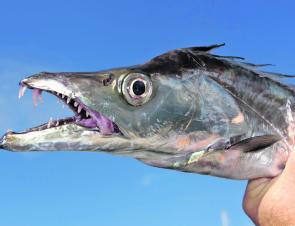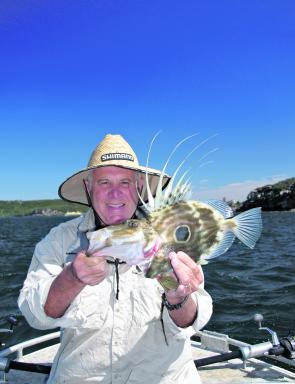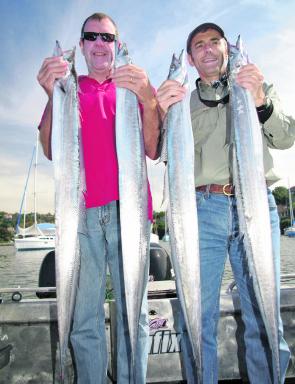The past season would have to be the most random and unpredictable we’ve ever experienced. Lots of fish were mysteriously absent for large chunks of the Summer season and fish that we normally expect to catch in the depths of Winter periodically showed up in good numbers.
John dory were taken from the various reefs and wrecks of the Harbour right throughout the warm-water period.
The mass of baitfish present in the Harbour this season was unprecedented and would have been part of what attracted the dory.
I have a theory, though, that there was a very cold undercurrent present off much of the east coast this season. It would explain why we didn’t see any blue water in the Harbour (the constant rain didn’t help, either), why the usual Summer species were so lethargic and why Winter species were in the Harbour despite the fact that the surface temp was generally up around 22°.
To support this theory my mate Benny Gross sent me some pictures of hairtail he caught off Dobroyd Point in late March. We picked up hairtail in North Harbour throughout April despite the surface water still being 21°.
It wasn’t just one or two, either: In our best session we hooked over20, landing a dozen. Hairtail in the middle of the day in 21° water in Sydney Harbour? What next?
This is the first time I’ve seen them in the Harbour in 20 years.
Cowan Creek, a tributary of the Hawkesbury, is nationally famous for hairies and for many years was thought to be their sole habitat. They are eel-like in appearance, don't fight too well and are pretty good on the plate, but it seems everyone has a fascination with them even if they don't have access to them.
When NSWFM Southern Sydney reporter Gary Brown, a fishing teacher from TAFE, was asked to lecture a Victorian TAFE fishing class, he asked if they had any preference on subjects. The reply was unanimous – hairtail.
The Windybank family, of Windybanks’ Bait and Tackle fame, were early pioneers of the Cowan system. They established the first boatshed and fished the waters professionally as far back as 1886.
They lived and ran the boatshed on Waratah Bay and can remember the first time the hairtail ever ventured into the system.
"Until about 1944 hairtail were only ever caught at Shark Rock, near the mouth," Grandma Windybank told me.
“Then one day the water in Waratah Bay just came alive with them. It was during the day and the surface bubbled with them as far as the eye can see.
“They were packed in so tightly that many died as they tangled in the reeds and up against the rocks. After that we caught them everywhere, right throughout the system and until the present day.”
Waratah Bay is still the most consistent location to take hairies but today they are unreliable and can turn up anywhere throughout the system at any time.
Their peak is during the cooler months. They are one freak of a fish and randomly turn up in other waterways like the Harbour, Botany Bay and Newcastle Harbour. I’ve even heard of them being caught as far north as Cairns and even PNG.
To further add to the mystery, nobody knows where they go when they are not in the rivers and harbours.
Live bait was traditionally the way to go but in the past few years many anglers have been turning to dead pillies with greater success. Pillies on ganged hooks or even more popular these days, a half-pillie on a single hook, seems to be the way to go.
A berley trail of cut pillies is a good start, just slip a hook into one every now and then. I suppose you'd call it cubing.
They also like yakkas and squid. I’ve caught them in Newcastle Harbour on lures and Fishabout guide Nick Martin got a few on lures in the Harbour this season. Whatever method you choose, just make sure the hooks are razor-sharp.
John dory are caught rarely and most of the few that are caught are taken accidentally. The main reasons for this are that the number of fishers venturing out at this time of year are dramatically reduced and the few that do bother don’t specifically target them.
Dory are almost exclusively taken on live bait but very occasionally one will be fooled by a pilchard aimed at tailor or, even more occasionally, cut bait aimed at bream or trevally.
A fair percentage of these incidental dory are taken after they inhale an undersized bream or reddie that has itself been hooked on a bream line.
Most bream fishos usually fish three or four lines, one in the hand and three in the holders. A small reddie picks up one of the baits on the set line and goes unnoticed or gets left there for a time while other chores are attended to.
In the meantime the dory, attracted to the boat by the swarms of baitfish swimming in the bream berley, zeros in on the struggling reddie and scoffs it. Usually the fisher will assume that the dory has taken the bream bait but those who dispatch and dress their dory immediately will discover the truth of the matter.
In Sydney Harbour john dory are found in deep water. They spend most of their time offshore in very deep water so when they come inshore they also feel more comfortable in the relatively deeper locations – 8m is a good starting depth.
They aren't the most energetic fish in the sea so strong currents are unfavourable. The still, deep bays and eddies of the lower Harbour, Middle Harbour and particularly North Harbour are good spots to start looking.
A final requirement on habitat is clear, saline water so the upper reaches are usually unsuitable except possibly after long periods without rain. That isn’t going to happen this year!
With that whopping great eye, the dory could possibly be nocturnal but I've never chased them at night so I can’t say for sure. One thing I do know is that they love a bit of shade and the low light of early morning and late afternoon.
Jetties and moorings are big favourites, as is other underwater structure.
As with most species, the turn of the tide seems to spark a feed, with high being the favourite and low not far behind.
The new and the full moon are good times though I'm not sure whether this is related to the moon phase or the fact that the turn of the high tides around these phases occur early morning and late afternoon. Probably the latter.
Bait must be alive. If you opt for live yellowtail or slimies, which I might add are most inappropriate, make sure you trim the tails to slow them down to dory speed. More natural prey are the slower reef-dwelling species like mado and sweep.
How you fish these baits is just as important as where and when.
Dory will pick bait up off the bottom but they much prefer if it is suspended a metre or so above the bottom. I find it much easier to set the depth without the bait on the hook.
Once you have set the depth, put the rod in the holder, pull the line up by hand and place the live bait on the hook. This way, although the bait will swim frantically for a few minutes, when it finally settles down you will know that it will be at the right depth. You cannot set the depth accurately with a frantic bait charging all over the place.
The rig is very basic. A 40g bean sinker is placed free running on the main line, stopped by a swivel. Then a 10kg trace, about 1m long is finished off with a 4/0 to 6/0 Mustad Big Red chemically sharpened hook.
You can get away with ordinary tackle with dory because they really aren't the toughest fighter but keep in mind that whenever you have a live bait out you risk hooking a kingie or jewfish.
Finally, shore-based fishos are well in with a shot at dory.
Jetties provide shade and swarms of baitfish and fishing straight off the rod tip among the pylons or a little further out under a bobby cork often produces more dory than the boats fishing out wider.
Reads: 4477
Hairtail in the middle of the day in 21° water in Sydney Harbour? What next?

Whatever method you choose to catch hairtail, just make sure the hooks are razor-sharp – matching the fish’s teeth.

The author theorises that there has been a cold undercurrent off Sydney and in the Harbour this year, making the water suitable for john dory.

Normally haunting the deep sunken valleys of the Hawkesbury system, hairtail have been regular Autumn encounters in the Harbour for the first time in 20 years, according to the author.




